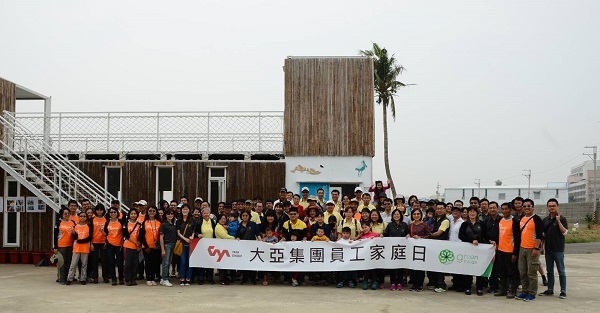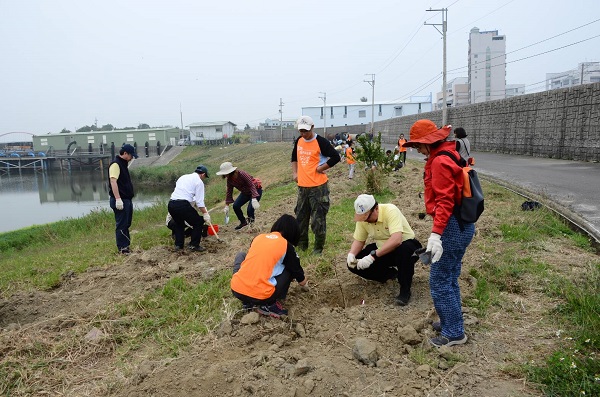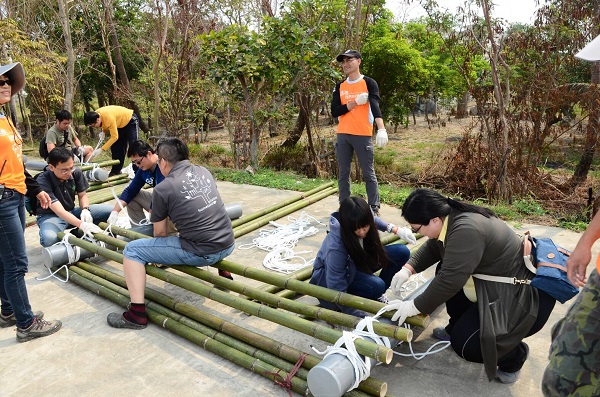Planting trees to welcome butterflies along the banks of Erren River – Connection to the earth and protecting natural ecology on Ta Ya’s Employee Family Day

2017/03/21
Ta Ya Group held its 2017 Employee Family Day activity on the morning of March 18th, inviting all employees and their family members to grow nectar plants for butterflies at Gangweigou River Detention Basin and build artificial floating islands for migratory birds as a way to enjoy a pleasant Saturday.
TAYA Pristine Homeland Foundation collaborated with the Wetlands Taiwan Organization for the first time to grow nectar plants for butterflies in the vicinity of Erren River Story House near the Gangweigou River Detention Basin in an effort to enrich the local biodiversity. At 9AM sharp on March 18, close to a hundred employees and their family members from Ta Ya, Ta Heng, AD Engineering, and Hengs Technology gathered at Erren River Story House.

Ta Ya Group Chairman Shen Shang-Hung greeted the participants and commented, “I am glad to see all of you gathered here today to do our part to contribute to the environment and learn something new while weele at it. There are many empty spaces here at Gangweigou River Detention Basin that needs our help to grow trees. The arbors and shrubs we will be planting today are all butterfly food and nectar plants and hopefully in the near future, we will see butterflies dancing gracefully in the air here.” Chang Jung Christian University River Conservation Center Director Hung Ching-Yi followed by explaining to everyone the function of the Gangweigou River Detention Basin and how it alleviates the issue of inundation in Baoan District on the behalf of the Wetlands Taiwan Organization.
In order to ensure that the plants could grow more steadily and improve their survival rate, saps were chosen for all the plants to be grown for the activity, be it arbors such as Chinese pistache, Japanese evodia, Clausena excavate or shrubs such as Asian Toddalia, Dregea volubilis and Japanese honeysuckle. Under the guidance of volunteers from the Wetlands Taiwan Organization, some participants were responsible for mixing the cultivated soil, while others drawn water to water the saps. The participants worked together and planted a total of 90 tender saps.


After a short rest and refreshment, the participants were split into multiple groups for the environmental education activity. Volunteers from the Wetlands Taiwan Organization presented a brief introduction to Erren River and the ecological environment at the Gangweigou River Detention Basin to the first group, while the second group had hands-on experience with collage art using natural materials. The activity was ideal for participants with young children as the young participants put their creativity to use and made interesting pictures using plant seeds, tree branches, and leaves. The third group of participants built artificial floating islands in order to create a better habitat for migratory birds. The task involved binding plastic tubes and bamboo together before securing coconut fiber mattress on top and it was a strenuous job. As it was in the middle of the day, everyone involved was drenched with sweat. With everyone working as a team, the group completed six artificial floating islands in less than two hours and were commended by volunteers of the Wetlands Taiwan Organization.
The Gangweigou River begins in Guanmiao and traverses past Guiren and Rende before converging with Erren River and as such, it is geographically very close to Ta Ya. The TAYA Pristine Homeland Foundation will be working together with Wetlands Taiwan Organization to maintain the ecological environment of the Detention Basin and contribute towards the goal of creating a pristine homeland.
News Vocabulary

